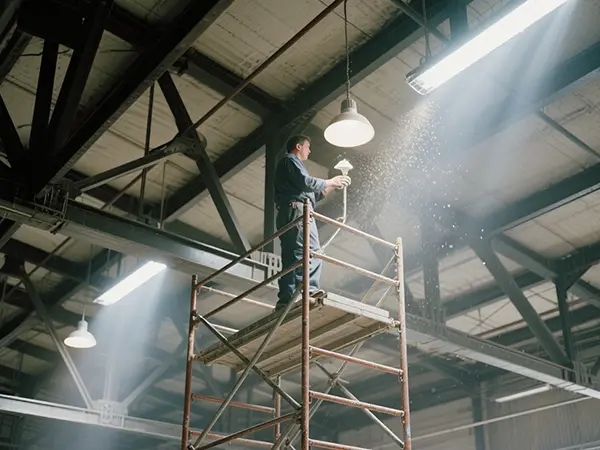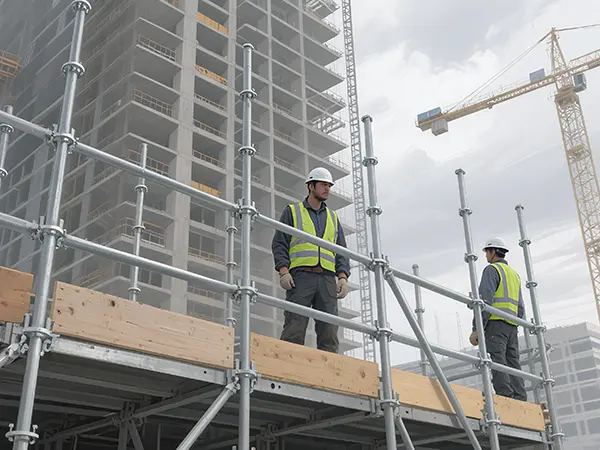Scaffold towers, also known as mobile towers or portable scaffolding, are indispensable tools in the construction and maintenance industries. Their lightweight design and versatility make them a favored choice for safely reaching elevated heights. These structures provide a stable platform for workers to perform tasks ranging from painting to construction. However, like any equipment used in construction, scaffold towers come with their own set of safety considerations. Ensuring your safety and the safety of those around you is paramount when using these towers. By understanding the potential risks and implementing proper safety measures, you can create a safer work environment. Let’s explore key safety tips for using scaffold towers effectively and safely.
Before diving into safety tips, it’s essential to understand what scaffold towers are and how they function. Scaffold towers are temporary structures used to support workers and materials during construction or maintenance work at height. They are engineered to offer a stable and secure platform for various tasks, minimizing the need for ladders that can be unstable. These towers come in various forms, including aluminium towers, mobile access towers, and alloy towers. Their portability and ease of assembly make them a practical choice for both small-scale and large-scale projects. Understanding the different types and features of scaffold towers can help you choose the right one for your specific needs.
- Aluminium Scaffold Tower: Known for being lightweight, these towers are easy to move and set up, making them ideal for quick jobs. They are resistant to rust, which makes them suitable for both indoor and outdoor use. Their design often includes features that make assembly straightforward, even for those with minimal experience.
- Mobile Scaffold Tower: These towers are designed to be moved easily, providing flexibility for jobs that require frequent relocation. Their wheels or casters allow workers to reposition the tower without disassembling it, saving time and effort. This mobility is particularly beneficial in large areas where tasks are spread out.
- Portable Scaffold Tower: Often used for smaller, indoor tasks, these towers can be assembled and disassembled with ease. They are compact and can be stored conveniently when not in use. Despite their smaller size, they offer a sturdy platform for a variety of tasks, from electrical work to painting.
- Ally Tower: A term often used interchangeably with aluminium towers, emphasizing their lightweight nature. These towers are favored for their ease of transport and setup, making them a go-to choice for contractors on the move. Their construction often includes features that enhance safety, such as guardrails and stabilizers.
When using scaffold towers, following safety guidelines can prevent accidents and injuries. Proper safety practices not only protect the workers but also ensure compliance with industry regulations. Here are some crucial safety tips:
Selecting the appropriate tower for your project is the first step. Consider the height you need to reach, the weight the tower must support, and the environment where you will use it. For instance, a lightweight aluminium scaffold tower
is suitable for indoor tasks, while a sturdier mobile scaffold might be necessary for outdoor work. The choice of tower should also factor in environmental conditions, such as wind exposure and ground stability, to minimize risks.

Before assembling or using any scaffold tower, conduct a thorough inspection. Check for any signs of damage or wear, such as bent frames or missing components. Ensure all parts are clean and free of debris to prevent slipping or other hazards. Regular inspections can identify potential issues before they escalate, making repairs and maintenance more manageable and preventing costly accidents.
Proper assembly is crucial for safety. Follow the manufacturer’s instructions closely, and ensure all parts are securely in place before climbing the tower. Pay special attention to locking mechanisms and stabilizers, which help maintain the tower’s balance. Incorrect assembly can lead to structural failures, so taking the time to double-check each step can save lives and prevent injuries.
Always set up scaffold towers on firm, level ground. Uneven or soft surfaces can lead to instability, increasing the risk of tipping over. If necessary, use base plates or adjustable legs to level the tower. Before starting work, inspect the ground conditions and make adjustments as needed to ensure a stable foundation.
Each scaffold tower has a maximum weight capacity, including workers, tools, and materials. Exceeding this limit can compromise the tower’s stability. Always adhere to the weight restrictions specified by the manufacturer. Overloading not only risks structural integrity but also increases the likelihood of accidents, particularly if the tower is on an incline.
The work platform should be secure and free of clutter. Use guardrails and toe boards to prevent falls and ensure that all tools and materials are organized to avoid tripping hazards. A tidy workspace reduces distractions and enables workers to focus on their tasks without the risk of stepping on misplaced tools or materials.
Weather can significantly impact scaffold tower safety. Avoid using towers during high winds, rain, or ice, as these conditions can make surfaces slippery and unstable. If you’re working outdoors, consider the forecast and plan accordingly. Delaying work in adverse weather conditions is always preferable to risking safety.
All workers using scaffold towers should receive proper training. They should understand how to assemble, disassemble, and safely operate the towers. Regular safety drills can reinforce these practices and ensure everyone is prepared for emergencies. Training should include identifying potential hazards and knowing the protocols for reporting and addressing them.
If you’re considering scaffold tower hire, there are additional factors to keep in mind. Hiring can be cost-effective, especially for short-term projects or occasional use. However, understanding the terms and conditions of hire is crucial to avoid unexpected costs. Here are some points to consider:
The cost of hiring a scaffold tower
can vary based on the tower type, hire duration, and locati0n. For instance, scaffold tower hire
in London may be priced differently than in other areas. It’s essential to compare scaffold hire rates and choose a provider that offers competitive pricing and reliable equipment. In addition to cost, consider the quality of customer service and the provider’s reputation in the industry.
When opting for portable scaffold tower hire, ensure the provider offers towers that meet your project’s specific needs. Consider factors such as tower height, weight capacity, and ease of assembly. Ask for equipment maintenance records to ensure the towers are in good condition and safe for use. A reputable provider will be transparent about their maintenance practices and offer support throughout the hire period.
Rental rates can be influenced by the length of the hire period and the tower’s features. Longer hire durations often come with discounts, so assess your project’s timeline before making a decision. Additionally, inquire about any additional fees for delivery, setup, or insurance, which can impact the overall cost. Understanding these details upfront can help you budget more effectively and avoid surprises.
Safety should always be a priority when using scaffold towers. By selecting the right equipment, following safety protocols, and considering hire options, you can ensure a secure working environment. Whether you’re using an aluminium scaffold tower
or opting for mobile scaffold hire, understanding these safety tips will help protect your team and complete your projects efficiently. Remember, a well-informed team is a safe team, and taking the time to implement these practices can make all the difference in maintaining safety on-site. Regular reviews of safety procedures and continuous education can further enhance safety culture within your organization, leading to safer and more productive project outcomes.


